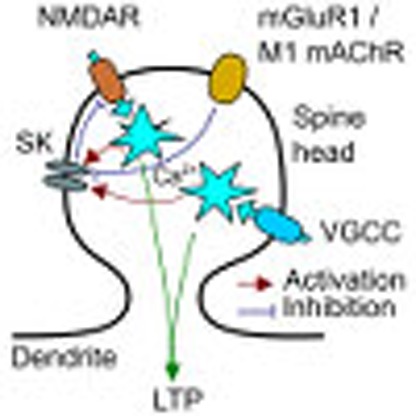- Record: found
- Abstract: found
- Article: found
Coordinated activation of distinct Ca 2+ sources and metabotropic glutamate receptors encodes Hebbian synaptic plasticity

Read this article at
Abstract
At glutamatergic synapses, induction of associative synaptic plasticity requires time-correlated presynaptic and postsynaptic spikes to activate postsynaptic NMDA receptors (NMDARs). The magnitudes of the ensuing Ca 2+ transients within dendritic spines are thought to determine the amplitude and direction of synaptic change. In contrast, we show that at mature hippocampal Schaffer collateral synapses the magnitudes of Ca 2+ transients during plasticity induction do not match this rule. Indeed, LTP induced by time-correlated pre- and postsynaptic spikes instead requires the sequential activation of NMDARs followed by voltage-sensitive Ca 2+ channels within dendritic spines. Furthermore, LTP requires inhibition of SK channels by mGluR1, which removes a negative feedback loop that constitutively regulates NMDARs. Therefore, rather than being controlled simply by the magnitude of the postsynaptic calcium rise, LTP induction requires the coordinated activation of distinct sources of Ca 2+ and mGluR1-dependent facilitation of NMDAR function.
Abstract
 During STDP, the magnitude of postsynaptic Ca
2+ transients is hypothesized to determine the strength of synaptic plasticity. Here,
the authors find that STDP in mature hippocampal synapses does not obey this rule
but instead relies on the coordinated activation of NMDARs and VGCCs and their regulation
by mGluRs and SK channels.
During STDP, the magnitude of postsynaptic Ca
2+ transients is hypothesized to determine the strength of synaptic plasticity. Here,
the authors find that STDP in mature hippocampal synapses does not obey this rule
but instead relies on the coordinated activation of NMDARs and VGCCs and their regulation
by mGluRs and SK channels.
Related collections
Most cited references57
- Record: found
- Abstract: found
- Article: not found
Regulation of synaptic efficacy by coincidence of postsynaptic APs and EPSPs.
- Record: found
- Abstract: found
- Article: not found
Synaptic modifications in cultured hippocampal neurons: dependence on spike timing, synaptic strength, and postsynaptic cell type.
- Record: found
- Abstract: found
- Article: not found